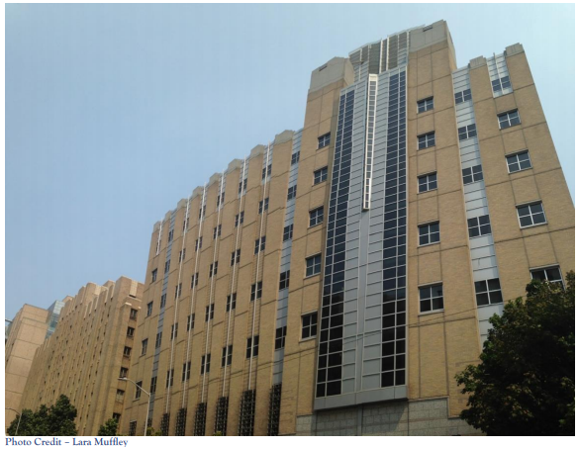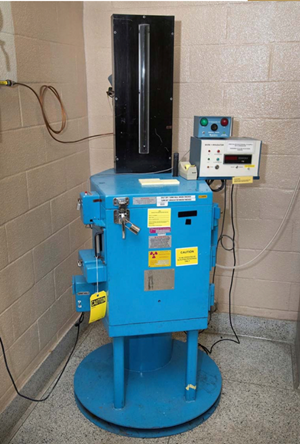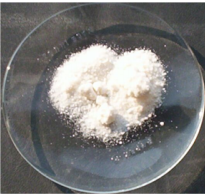 Photo credit: Lara Muffley
Photo credit: Lara Muffley
 On May 2, 2019, the Harborview Research & Training Building was closed after a small amount of a radioactive material called cesium-137 was released on the building's loading dock by a Department of Energy (DOE) sub-contractor that was removing a piece of equipment called an irradiator.
On May 2, 2019, the Harborview Research & Training Building was closed after a small amount of a radioactive material called cesium-137 was released on the building's loading dock by a Department of Energy (DOE) sub-contractor that was removing a piece of equipment called an irradiator.
 Irradiator
Irradiator
Researchers and other personnel who worked in the building were relocated to other spaces on University of Washington (UW) campuses while an assessment and clean-up of the building was initiated. Conference rooms and the auditorium were also closed.
The Washington State Department of Health (DOH) Radiation Protection Program restricted access to the R&T Building while DOE, Los Alamos National Laboratory, Pacific Northwest National Laboratory (PNNL), and their sub-contractors assessed, cleaned, and remediated the building. On April 29, 2021, DOH released the building from radiological controls and monitoring associated with the cesium release. The building is now back to normal operations.
Read the investigation report for more information about the incident.
What was done to clean up the contamination?
Distribution of cesium-137 following the release affected many areas of the building, and the amount varied based on the floor level and location within the building.
The clean-up contractor, with oversight by DOE, DOH and the University, cleaned the cesium-137 to very low levels by doing the following:
 Cesium chloride powder
Cesium chloride powder
- Wiped down surfaces
- Removed concrete surfaces
- Removed contaminated equipment
- Removed contaminated building materials
Portions of the facility’s interior, including the ventilation system, elevators, interior walls, flooring, equipment, fans, freezers and the mechanical infrastructure were either cleaned or removed and replaced. Areas adjacent to the building, including the oxygen farm to the east, were thoroughly surveyed to ensure that contamination was cleaned from outdoor surfaces to very low levels.
What has the University done to ensure safety of people who occupy the R&T Building?
The University’s highest priority has been to make sure the building is as safe as possible for people reoccupying the building. The University insisted on stringent approaches for the cleaning of the building that not only ensures the health and safety of all people who use the building but goes further to ensure that the amount of remaining cesium-137 is as low as reasonably achievable.
The UW focus on stringent remediation approaches ultimately resulted in the building being cleaned to a level such that the exposure to anyone working in the building does not exceed 1 millirem per year, a number that is considered negligible and far below DOH and U.S. Environmental Protection Agency (EPA) limits. For comparison, people living in the United States are, on average, exposed to 620 millirems (mrem) of radiation per year; flying across the country from west coast to east coast exposes an individual to about 3.5 mrem.
Additional resources regarding the relative risk of exposure to radiation sources are provided below.
What was done to reoccupy the R&T Building?
The University submitted a detailed report on the clean-up efforts to DOH, the agency responsible for releasing the building for occupancy. DOH reviewed the report and conducted their own independent sampling as part of their review process to determine the building is safe for normal occupancy. On April 29, 2021, DOH released the building of all restrictions.
UW School of Medicine faculty and staff began moving into the building after DOH released the building of all restrictions. Harborview Medical Center employees who maintain the facility, including Engineering, Environmental Services and Security, as well as UW groups, such as UW-IT, Scientific Instruments also began providing services to the building. These and other groups returning to the building were offered training on and an opportunity to ask questions about the clean-up work. Links to some of these presentations are provided below.
Timeline
The two-year remediation process occurred in five phases:
Phase 1: Initial survey of contamination
- Identified impacted areas (about 80% of building sustained low impact, basement and sub-basement were not impacted, highly impacted areas included areas closest to the 2nd floor loading dock)
- Began in May 2019
- Completed in July 2019
Phase 2: Removal of irradiator and cesium-137 source
- Completed in August 2019
Phase 3: Characterization and remediation of highly impacted areas
- Field work completed in December 2020
- Data summaries & reports completed and submitted to DOH in March 2021
- Release of building by DOH on April 29, 2021
Phase 4: Building reconstruction
- Began during Phase 3 work
- Completed on November 1, 2022
Phase 5: Reoccupy R&T
- Conducted between May and July, 2021
Radiation sources and annual dose
Radiation is energy from natural and man-made sources in the form of energy waves or energized particles. Radiation from natural (e.g., rocks, space, water) and man-made (e.g., x-rays) sources is absorbed by our bodies.
Read the Radiation and Relative Risk Focus Sheet for information about the annual dose of radiation for a person living in the United States, estimated to be 620 millirem.
You can use the Environmental Protection Agency’s Radiation Dose Calculator to estimate the amount of radiation you are exposed to annually based on your medical procedures, region of the country, elevation, travel, occupation, residence and other sources.
More information
Previously recorded presentations are available for viewing that provide detailed information on the steps taken to ensure a safe return to the R&T Building:
- School of Medicine video and presentation on 2/25/21 (UW NetID required)
- Environmental Health & Safety Department video and presentation on 4/5/21 (UW NetID required)
- UW Surplus video and presentation on 4/7/21 (UWNetID required)
- School of Medicine video on 4/15/21 (UWNetID required)
- Department of Comparative Medicine video and presentation on 4/15/21 (UW NetID required)
- UW-IT video and presentation on 5/12/21 (UW NetID required)
If you have questions, please contact the EH&S Radiation Safety team at radsaf@uw.edu or 206.543.0463.